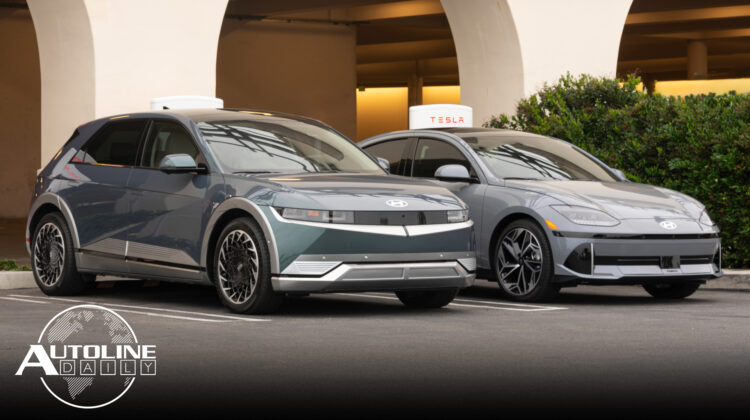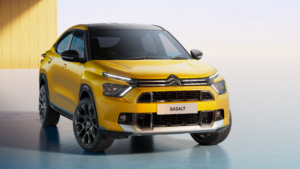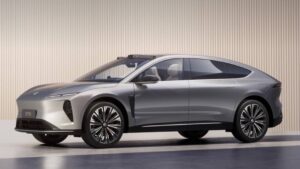
Follow us on social media:
Runtime: 9:46
0:00 Stellantis Slashes 2,500 Jobs in Italy
0:59 BYD’s 2023 Earnings Soar
2:19 Hyundai Invests $51 Billion In EVs & SDVs
2:50 Plastic Omnium Changes Name to OPmobility
4:37 Citroen Reveals New Basalt Small SUV
5:27 Honda Establishes New F1 Base in the UK
6:11 JD Power: EV Owners Not Happy with Tire Wear
7:01 Forvia Intelligent Headlights Coming to U.S. This Year
8:02 Nio ET9 To Feature 1st Mass-Produced 900V Drive Unit
Visit our sponsor to thank them for their support of Autoline Daily: Bridgestone and Intrepid Control Systems.
This is Autoline Daily, the show dedicated to enthusiasts of the global automotive industry.
STELLANTIS SLASHES 2,500 JOBS IN ITALY
Stellantis is deeply worried about the transition to electric vehicles and intense competition from Chinese automakers. So it’s cutting more jobs, this time in Italy. Last week, it laid off 400 engineering employees in the U.S. Now, it has reached deals with labor unions at several plants in Italy to slash at least 2,500 jobs. But the cuts are voluntary, with Stellantis offering buy-out packages to workers close to retirement or those looking for a new opportunity. Stellantis says it will announce more agreements at other sites in Italy in the coming days, so it sounds like more layoffs are on the way. Stellantis currently employs 43,000 people in Italy, down from around 55,000 in 2021 when the automotive group was formed.
BYD’S 2023 EARNINGS SOAR
Speaking of intense competition from Chinese automakers, BYD reported its 2023 financial results and the company is experiencing rocket-like growth. It sold 3 million vehicles last year, up 45% from the year before. That means it broke into the rankings of the top 10 car companies in the world, surpassing Mercedes, BMW, and Renault and it’s right on the heels of Nissan. Revenue came in at $83.3 billion, up 42%. Its gross profit margin hit 20%. It posted an operating profit of nearly $5.3 billion, which was up nearly 77%, and it made a net profit of $4.1 billion, which was up 80%. By the way, that net profit nearly matches the $4.3 billion Ford made last year. Just to give you an idea of how vertically integrated BYD is, it has over 703,000 employees, which is more than Volkswagen or Toyota. Keep in mind that BYD doesn’t just make cars. It also makes cell phones and semiconductors, but automotive accounts for 80% of the company’s business, which is up from 76% the year before.
HYUNDAI INVESTS $51 BILLION IN EVs & SDVs
There’s no question that the transition to EVs is costing a boatload of money. The Hyundai Group announced it’s investing $51 billion over the next three years in EVs and Software Defined Vehicles and will also hire 81,000 new employees. More than half of the money will be used for new R&D infrastructure and EV assembly lines. And most of the rest will go towards R&D for EVs, including software defined vehicles and battery technology.
PLASTIC OMNIUM CHANGES NAME TO OPMOBILITY
Car sales in Europe are still running about 5 million units a year lower than they were pre-Covid. So the French auto parts supplier, Plastic Omnium, wants to become less reliant on the European market. It’s planning more investments in the U.S. and it’s also changing its name. As you can probably guess, the company specialized in plastics but it’s growing its business to include EV and hydrogen technology. So it’s changing its name from Plastic Omnium to OPmobility. It will open a new plant in Texas next month and is investing in one in Michigan for fuel cells. The company’s CEO says it expects its U.S. revenue to double by 2028. Last year, it was 1.6 billion euros, or about 14% of its total revenue.
CITROEN REVEALS NEW BASALT SMALL SUV
Citroen revealed an all-new compact fastback SUV, called the Basalt, that it’s going to sell in India and South America. It’s built on the same platform as the C3 and C3 Aircross and features a similar design language as those vehicles. But development of the Basalt also benefited from direct involvement of teams from the regions and in the future Citroen says it will produce vehicles locally. While it’s not revealing what will power the model, we would expect a similar lineup as the C3, which is available with a range of gas and diesel 3-cylinder engines, including hybrids and even the option for pure electric. The Basalt will join the C3 and C3 Aircross in India and South America in the second half of this year.
HONDA ESTABLISHES NEW F1 BASE IN THE UK
Honda engines have been dominating Formula 1 for the last couple of seasons, which has made it a sought-after supplier. It currently has a partnership with the Red Bull teams to provide them with power units until next year and when rules change in 2026 that will require about 3-times the electrical power, Honda will also start supplying power units to Aston Martin racing. In order to support those efforts, the company’s racing division is creating a new subsidiary in the UK, called Honda Racing Corporation UK. Its main task will be performing post-race maintenance and preparation on F1 power units, but it will also act as a logistics operation for the European region.
JD POWER: EV OWNERS NOT HAPPY WITH TIRE WEAR
EV owners will save money by charging at home and having a lot less maintenance to do, like no need for oil changes and tuneups. But some of that will be offset by spending more on replacing tires. J.D. Power’s 2024 U.S. Original Equipment Tire Customer Satisfaction Study found that EV owners reported their tires wear out faster due to the weight and power of electric cars. Automotive News reports that this could be a good source of business for dealerships, including tire service. But right now, there’s some variation in recommended service. Mustang Mach E owners are told to rotate their tires every 10,000 miles. For the Hyundai Ioniq 6 it’s every 8,500 miles, and for the Hummer EV it’s every 7,500.
FORVIA INTELLIGENT HEADLIGHTS COMING TO U.S. THIS YEAR
One of the most common complaints we hear are about bright headlights that blind oncoming drivers. Well, Forvia has a solution to that. It developed headlamps that use 14,000 miniature LED pixels that are really bright, but the pixels can be individually turned on or off. So, when you’re coming towards a car like this at night, the headlight turns off the pixels that would normally shine right in your eyes. Same thing for the car in front of you. Your brights won’t show up in their rear-view mirrors. Once a car goes over 25 miles an hour, the headlights automatically go to high beam. And you can practically drive with your brights on all the time without blinding anyone. This technology has been available in Europe for a number of years and Forvia says they will probably hit the U.S. market this year, but it will not identify which manufacturer will use them. These lamps can actually do a lot more than what we’ve shown you here and we’ll be posting a video that gets into a lot more detail.
NIO ET9 TO FEATURE WORLD’S 1ST MASS-PRODUCED 900V DRIVE UNIT
NIO is pioneering some interesting technologies on its new flagship EV, the ET9, which should be out sometime next year. We’ve previously reported how it could be the first by-wire vehicle, meaning the throttle, gear shifts, suspension, steering and brakes will all be controlled with electronic inputs. Now CarNewsChina reports the ET9 will feature the world’s first mass-produced 900-volt drive unit. It’s a 925V W-Pin synchronous permanent magnet motor that uses continuous wave winding technology. It weighs just 79 kilograms or about 175 pounds, but produces up to 340 kW or nearly 456 horsepower. One of these drive units will power the rear wheels, while an asynchronous induction motor with up to 180 kW or 241 horsepower will drive the front wheels. NIO says the 900V unit is also smaller and lighter by about 30%.
And that brings us to the end of today’s show. Thanks for making Autoline a part of your day.
Thanks to our partner for embedding Autoline Daily on its website: WardsAuto.com









Maybe EVs should have a “tire saver” button to prevent people from routinely slipping the tires during low speed acceleration, where electric motors have maximum torque. Looking over some specs, most EVs seem to have tires “sized for the weight,” so except for “slippage,” EV tires shouldn’t wear out much faster than ICE vehicle with similar weight and tire size. It’s the right foot of the driver.
The Forvia headlights sound like a great concept, though likely an expensive one. I have heard of this type of tech for several years now but our federal gov’t has been very slow in evaluating and approving it. Situation normal for those folks. Meanwhile, even when this gets approved, it won’t stop the morons from buying aftermarket LED lights or blue-tinted fakes that spray massive glare in all directions. Most of these Saturday Mechanics don’t make any effort to make sure the lights are properly aimed, making driving an unpleasant experience for everyone that approaches them on the road. The icing on the cake is the widespread daily use of fog lights. This just doubles the amount of glare for other motorists. The only motorists that it seemingly does not affect are the police. I have yet to see anyone getting a ticket or even a friendly warning about improper use of headlights. OK, rant done!
I like the light technology. My current car has automatic high beam lights. It works well even though sometimes I think they stay on a tick too long when cars are approaching. I don’t know that ultimately these lights bring any real benefit for those who are not regularly driving rural roads where you have to watch for deer or other animals randomly crossing. I wonder about how it is for the city where you can potentially blast the sidewalks with light glare. Or maybe there is a light sensor that detects enough ambient light, such as from streetlights, and dims the lights appropriately. I turn off the automatic high beams on my car when I am driving in the city. It will be an interesting review when ALD posts it.
I find it ironic that manufacturers overpower their EVs then people complain about tire wear. Our Bolt EV has 200 hp and you can get it slipping quite easily even with just a 6.5 sec 0-60. But it’s controllable.
I can’t recall a question or comment about any ICE car wearing out tires early, despite their enormous horse power. Just more EV bashing. By the way, we have 80,000 km on our Bolt EV on original tires with lots of life left. It’s all a non-issue.
Lights aimed too high are annoying, but the people who should go to jail are the ones who put dark grey things over headlights and tail lights, so they can’t see, and you can’t see them.
One of my cars has automatic high beam, but I never use it.
The DOT was slow in allowing anything other than 7 inch round sealelrd beams, and in 1957, smaller, quad sealed beams, and in the “70s, rectangular sealed beams. They went from that to “anything goes,” including lights that look way too bright to opposing traffic.
In an effort to lower the price of EVs maybe forget about including AV and software defined vehicles. If that is so expensive just make a normal vehicle that happens to be electrically powered. I think everyone thought in order to be successful like Tesla that those things need to be part of an EV. I disagree.
Yep, as Abermarle stated, as long as alignment is correct, the way you drive is what determines tire life, EV or ICE. Of course, tire life varies drastically by make and model of the tires.
Lambo2015 — I 100% agree! An electrical power train and battery are just a type of propulsion and it seems that a lot of the challenges has nothing to do with that basic concept. I understand that the motors and the battery power used, has to be run as efficiently as possible and there has to be system checks to maintain temperatures, to prevent thermal run away. These kinds of systems, though a different type, are also present with ICE vehicles as well. While over the air updates are convenient, vehicle software updates still happened before that was the going trend. They were just done for free at the dealer. It just seems that cooking that kind of software and others like it, is part of what maybe adding to the cost of EVs, along with the battery. While convenient, is it necessary? As cool as the Cybertruck’s stir-by-wire tech is, what’s wrong with the current system? While it might cost the OEM pennies on the dollar to install during manufacturing, how much does it cost to design, R&D, code and then add that cost on to the final product? Then the possible warranty cost should it fail in the field? What made the Model S the original success that it is, was that the EV tech (motors and batteries and the equipment that managed it) worked as it was designed. Type kind of propulsion proved to be competitive to ICE vehicles and had a charging network to support it.
I would consider an EV if they made something small but attractive that I could take to work and back and throw a 240V charger on it at home. I don’t need any autonomous features. I don’t need 300 miles of range as it would be a work car not anything I would travel in. In fact, a nice two-seater like the old Pontiac Fiero, Toyota MR2, or Mazda Miata would be perfect. But not priced like the Tesla roadster. Make it affordable. I just want power windows and locks, AC and cruise control and a radio with phone conductivity. I don’t care about an enormous touch screen. The only other options I would maybe consider would be heated seats and wheel. If the design was attractive enough to offer a convertible or targa top option, I would consider that too but I’m just not sure why a small commuter car cannot be attractive. I don’t want a Chevy Bolt looking thing.
Lambo, since you don’t like the looks of the Bolt, how about a Leaf or Kona EV? Then, there’s the MIni EV, but it has very short range.
In a year or two, there will be a nice EV commuter car, but it won’t be cheap. Porsche is going to have an electric replacement for Cayman/Boxster.
Lambo,
You can get a Fisker Ocean Sport SUV for $25K before tax credits as Fisker has put them on a fire sale. It meets all those needs and looks pretty decent. The down side is that Fisker may not be a company too much longer. So you would be rolling the dice.
Yeah, the Fisker is a “bargain,” but with the company gone in a few months, the car would depreciate horrendously, and there would be no parts or support. Also, CRs first drive report describes the Ocean as “Unfinished Business.”
This blog has become like the Baghdad Bob of EV evangelism preaching about our EV future in the face of weekly hard news about how they are really (not) selling. People don’t want them. The big automakers have idled their plants, continue mass layoffs, and delayed rollouts and planned ICE phaseouts as they bleed billions of dollars in losses and can’t sell the ones already on lots. Dealers lobby against them. The one Cadillac dealer in my city has had the same Lyriq on their show floor for 4 years. Cities have spent literal millions of dollars on EV bus fleets that sit broken in parking lots and can’t be repaired.
Porsche will make you buy two or three Teycans to earn the privilege of buying an ICE GT3 because they can’t sell them otherwise and won’t take any back as trade in. They depreciate massively because everyone is afraid of that $20k or more battery replacement cost so the used market will never really materialize. Making an EV basically the latest disposable electronics device. So be prepared to have to “throw away” your EV at some point, and possibly still be paying on the loan when you do. How many Nissan Leafs do you see one the road?
It’s nuts and this “blog of the auto industry” should be more honest about the facts on the ground.